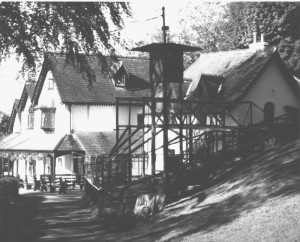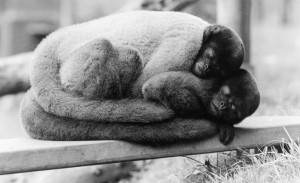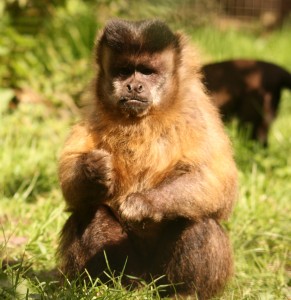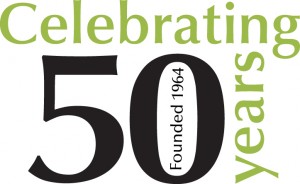History
 Wild Futures began life in 1964 as The Monkey Sanctuary; a centre which offered refuge to woolly monkeys rescued from the pet trade, following a rapid growth in the popularity of keeping exotic animals in the 1950s and 1960s. Recognising that monkeys are social beings and inherently unsuitable for keeping in isolation in domestic situations, the Sanctuary’s founder, Len Williams established the project in Cornwall, on the site where the Wild Futures’ Monkey Sanctuary is found today. Read the story of Len and Lulu here.
Wild Futures began life in 1964 as The Monkey Sanctuary; a centre which offered refuge to woolly monkeys rescued from the pet trade, following a rapid growth in the popularity of keeping exotic animals in the 1950s and 1960s. Recognising that monkeys are social beings and inherently unsuitable for keeping in isolation in domestic situations, the Sanctuary’s founder, Len Williams established the project in Cornwall, on the site where the Wild Futures’ Monkey Sanctuary is found today. Read the story of Len and Lulu here.
From providing care for the initial five monkeys, The Monkey Sanctuary embarked on a period of growth, becoming the first centre in the world to successfully breed woolly monkeys, with its residents living out long and active lives. The high welfare standards and innovative territory design allowed for maximum social interactions and the possibility for the monkeys to live in close-to-natural colonies. This led to the continued success of the centre and a reputation for excellence in the world of primate welfare. To date, over 150 monkeys have been cared for at The Monkey Sanctuary.
 The organisation grew organically over the years, building from a few dedicated volunteer keepers to an extensive and skilled team of almost 20 people working in diverse areas; including primate welfare, campaigning, environmental education, sustainability and support of overseas projects. To accommodate these changes, The Monkey Sanctuary went from being a private project, to a workers’ cooperative, before gaining charitable status as The Monkey Sanctuary Trust in 2004.
The organisation grew organically over the years, building from a few dedicated volunteer keepers to an extensive and skilled team of almost 20 people working in diverse areas; including primate welfare, campaigning, environmental education, sustainability and support of overseas projects. To accommodate these changes, The Monkey Sanctuary went from being a private project, to a workers’ cooperative, before gaining charitable status as The Monkey Sanctuary Trust in 2004.
By this time, The Monkey Sanctuary had already ended its breeding programme for the woolly monkeys due to a complex set of factors; not least that the chance of their release was becoming increasingly remote as more information became available on the implications of rehabilitating ex-captive monkeys back into the wild. The Sanctuary thus took the decision to return to rescuing from the pet trade, which was, and still is, thriving in the UK almost five decades after its inception.
 Frosty the capuchin was rescued in 2001 and was the first non-woolly monkey to live at the Sanctuary. He was soon joined by a (still-growing) group of capuchin monkeys rescued from lives of isolation and inadequate care as pets. Today these monkeys form cohesive social groups who live in specially designed enclosures where they can exercise, play and rest with their monkey companions, whilst being provided with specialist care for life. The Sanctuary is now home to several different species of monkey and has plans to expand its rescue work to offer homes to more monkeys in the next 10 years.
Frosty the capuchin was rescued in 2001 and was the first non-woolly monkey to live at the Sanctuary. He was soon joined by a (still-growing) group of capuchin monkeys rescued from lives of isolation and inadequate care as pets. Today these monkeys form cohesive social groups who live in specially designed enclosures where they can exercise, play and rest with their monkey companions, whilst being provided with specialist care for life. The Sanctuary is now home to several different species of monkey and has plans to expand its rescue work to offer homes to more monkeys in the next 10 years.
Whilst caring for more rescued monkeys, The Monkey Sanctuary Trust had also continued to build upon its other key areas of work; becoming leaders and advisors at government level, both in the UK and abroad, in the campaign to end the primate pet trade; delivering far-reaching environmental education programmes; winning awards for sustainable practice and employing wildlife management techniques to protect habitats in the UK, as well as supporting primate conservation projects overseas. So much was the increase in work in these areas that, following a review of all operations in 2009, the current team concluded that The Monkey Sanctuary Trust was no longer a suitable name for an organisation that was achieving much more than simply offering sanctuary to rescued monkeys.
 It was from this review that the name of Wild Futures was born. The change in name did not mean a move away from the work the charity had championed for decades. The Monkey Sanctuary still exists as a flagship project of Wild Futures and continues to be a primary focus of its primate welfare and rehabilitation work.
It was from this review that the name of Wild Futures was born. The change in name did not mean a move away from the work the charity had championed for decades. The Monkey Sanctuary still exists as a flagship project of Wild Futures and continues to be a primary focus of its primate welfare and rehabilitation work.
